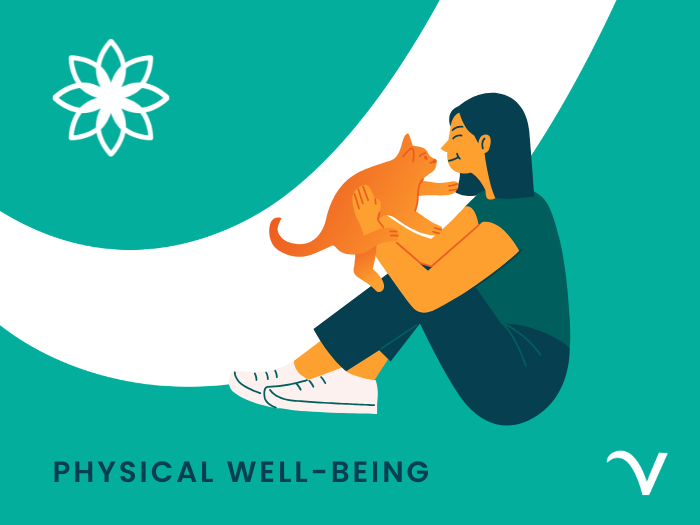November Wellness Corner

November 10, 2022
Mental Health Corner
Break the Cycle: Managing OCD
Have you ever seen someone perform a specific, repetitive motion and then laugh it off by saying “I’m so OCD”? While repetitive motions are often a symptom of OCD, or Obsessive-Compulsive Disorder, OCD isn’t anything to laugh about.
It is estimated to be present in 2-3% of the population and is characterized by cycles of obsessions, anxiety, compulsions, and relief. Below are common examples of intrusive, obsessive thoughts and compulsions:
- Fears about germs, disease, or hygiene
- Having unwanted, disturbing thoughts
- Fears about harming yourself or others
- Repeated cleaning rituals (e.g., washing hands repeatedly, disinfecting doorknobs)
- Repeating words or phrases mentally
- Ordering or arranging things
Performing these actions can sometimes bring brief relief from the anxiety that the obsessions and compulsions create, but it often doesn’t last. People who have OCD often struggle to know whether the compulsive activities they undertake are reasonable or not.
There are multiple ways to treat OCD, but the most common, effective treatment is a combination of therapy and medication. Cognitive behavioral therapy (CBT) is often used to help give people with OCD better coping skills to manage their obsessions and compulsions, and by extension to relieve their anxiety. Exposure and response prevention is a specific kind of CBT that works by exposing someone with OCD to things that make them anxious a little bit at a time to help them learn to respond in healthier ways. Antidepressants are often the first line of medication used for OCD. This isn’t because OCD corresponds with depression, but because it has been demonstrated that these medications work well for OCD, too.
If any of these symptoms sound familiar to you and are causing significant distress and/or disruption to your daily life, talk to your primary care physician. They can help you take next steps toward testing, diagnosis, and treatment.
Physical Health Corner
Incorporating more fish into your diet can be highly beneficial.
Nutrients that can be found in fish include:
- Omega-3 fatty acids. This nutrient can be linked to benefitting heart health, aiding in growth and development, potentially fighting depression and other mental health conditions, reducing the risk of autoimmune diabetes, and possibly protecting against vision loss in old age.
- Vitamin D. Many people don’t get enough Vitamin D, which acts like a steroid hormone, controlling blood calcium concentration and impacting your immune system. Vitamin D has been speculated to help defend against autoimmune diseases and improve sleep quality. If you don’t get much sunshine, incorporating fish into your diet is a great way to supplement Vitamin D.
41.6% of people in the U.S. are deficient in vitamin D, according to nutrition research.
Not only is fish loaded with nutrients, but it has been proven to help with a number of health risks including improving the quality of sleep. Eating fish might also help increase brain health and prevent asthma in children. Fish is packed with protein and iodine, as well.
Want to incorporate more fish into your diet but don’t know where to start? Salmon is always a good option. Like most fish, it can be cooked a variety of ways including baking, frying, broiling or searing. Fish oils like cod liver oil are also great sources of vitamin D, with more than 200% of its daily value in one tablespoon! Try adding fish or fish oil to a meal at least twice a week to reap the fish-ilicious benefits.
Social Health Corner
Recognizing Domestic Abuse
Coworkers, friends, and family are very important parts of our lives. One way to keep them safe and loved is to know the signs of domestic abuse. Domestic abuse or violence refers to physical, sexual, or emotional abuse from someone in your life – either same sex or opposite sex. Abuse can be difficult to spot. Often this abuse goes unreported due to fear or wanting to protect the abuser.
Signs of domestic abuse include:
- Verbal abuse such as insulting, demeaning, or shaming
- Extreme jealousy
- Preventing or discouraging you from spending time with family or friends
- Intimidation or threats
- Unexplained injuries
- Any physical violence or destruction of belongings
According to the CDC, 1 in 5 women and 1 in 7 men experience domestic violence in their lifetime.
If you’re worried that a friend, coworker, or family member might be in a harmful situation, your first instinct might be to intervene directly. However, that could cause more harm than good. Rather, consider these actions:
- Ask them in a private setting if they are safe
- Provide resources such as The National Domestic Violence Hotline*
- Offer to drive them to a local shelter
- Help them file for a restraining order
- Call the police if you suspect someone is in immediate danger of being harmed
- Don’t judge or blame them
If you suspect a friend, coworker, or family member of being an abuser, hold them accountable. Help them find treatment but let them know there are no excuses for abuse. Again, call the police if you suspect someone is in immediate danger of being harmed.
A list of additional resources:
- The National Domestic Violence Hotline: Available by phone, chat, or text at any time.
- A list of local resources organized by state and territory.
- The Department of Justice Domestic Violence homepage.
- Information on Protecting Yourself and Your Children from Domestic Violence.
Your health and wellbeing matter to us. Your career matters to us. You matter to us.
Saajan Bhakta, PhD (Psychology)
Certified Compassion Fatigue Professional
Director of Wellness & Transitions




